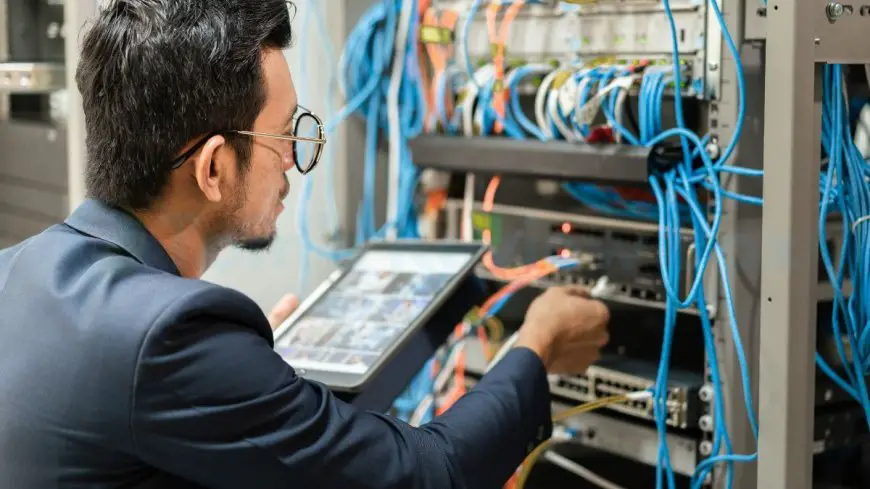Setting Up a Server for a Small Business: Complete Guide
Learn how to set up a server for a small business with our comprehensive guide. Gain the knowledge and expertise needed to succeed.

Did you know that 60% of small businesses that suffer data loss shut down within six months? Setting up a server for a small business is not just an option; it's a necessity for safeguarding your valuable information. By establishing a server, you can enhance data security, improve collaboration among team members, and ensure reliable access to critical files anytime, anywhere.
From choosing the right hardware and software to configuring settings and ensuring data backups, we will guide you through the process step by step. Stay tuned to learn how to protect your business data effectively and streamline operations.
Key Takeaways
-
Understand the Importance of Servers: Servers are crucial for small businesses to store, manage, and share data efficiently.
-
Choose the Right Server Hardware: Select hardware that meets your business needs in terms of performance, storage, and scalability.
-
Select the Operating System Carefully: Opt for an operating system that is compatible with your applications and offers the required security features.
-
Consider Server Location Thoughtfully: Decide on a server location that ensures accessibility, security, and compliance with data regulations.
-
Implement Security Measures Proactively: Secure your server with firewalls, encryption, regular updates, and user authentication to protect sensitive business data.
-
Optimize Server Performance: Regularly monitor and fine-tune your server to enhance speed, reliability, and overall efficiency.
Understanding Servers
Server Basics
A server is a computer system that provides services or resources to other computers on a network. Its primary function in a small business setting is to manage data, applications, and services efficiently. Servers play a crucial role in centralizing resources, enabling easy access to shared files and applications for all employees. The significance of servers lies in their ability to prioritize resources, ensuring that critical tasks receive the necessary computing power first. Moreover, servers enhance data security by centralizing storage and implementing robust security measures.
Types of Servers
In small business environments, different types of servers serve specific functions. File servers store and manage files, allowing users to access shared documents easily. Web servers host websites and web applications, making them accessible over the internet. Mail servers handle email communication, ensuring reliable delivery of messages within the organization. Each server type contributes uniquely to business operations by facilitating seamless collaboration, online presence, and efficient communication. By understanding the roles of each server type, businesses can choose the most appropriate solution based on their needs.
-
File servers: Store and manage files for easy access.
-
Web servers: Host websites and web applications.
-
Mail servers: Handle email communication within the organization.
Cloud vs On-premise
When deciding between cloud-based and on-premise server solutions for small businesses, it's essential to consider several factors. Cloud servers offer flexibility, scalability, and cost-effectiveness as they are hosted off-site by a third-party provider. On the other hand, on-premise servers provide businesses with more control over their data security and customization options but require higher upfront costs and maintenance efforts. Choosing between cloud and on-premise solutions depends on factors like budget constraints, scalability requirements, and IT expertise within the organization.
-
Cloud-based servers: Offer flexibility and scalability.
-
On-premise servers: Provide control over data security and customization options.
Server Hardware Selection
Cost-effective Choices
Small businesses can opt for budget-friendly server hardware like entry-level servers or refurbished models. Consider open-source operating systems to cut down costs significantly. Using virtualization can help maximize resource utilization and save on hardware expenses.
When setting up a server for a small business, it's crucial to minimize initial investments while ensuring long-term affordability. By carefully planning the server setup, businesses can reduce operational expenses such as maintenance and upgrades. Utilizing energy-efficient hardware can also lead to cost savings in the long run.
To reduce server-related costs without compromising performance, consider cloud-based solutions for specific functions instead of investing in additional hardware. Regularly monitoring and optimizing server usage can help identify areas where costs can be trimmed without affecting operations.
Hardware Requirements
Essential components for a small business server include a reliable processor, sufficient RAM, storage drives, and network interfaces. It's vital to choose hardware that aligns with the business's current needs while allowing room for future growth.
Selecting server hardware based on performance is crucial to ensure smooth operations. Businesses should consider factors like processing power, memory capacity, and storage options when choosing components. Scalability is essential to accommodate future expansion, so selecting modular hardware is advisable.
For small businesses with budget constraints, balancing performance requirements with available finances is key. Opting for mid-range hardware that offers a good balance between performance and cost-effectiveness can be a wise choice. Prioritize components that provide the best value for the business's specific operational demands.
Customizing Your Server
Customizing a server allows small businesses to tailor their setup to meet unique requirements efficiently. By selecting components based on specific needs, businesses can optimize performance and efficiency. Custom-built servers offer greater flexibility in terms of upgrading and scaling according to evolving business needs.
Guidance on selecting and configuring server components ensures optimal performance tailored to the business's operations. Businesses can choose processors, RAM modules, storage drives, and networking equipment that best suit their requirements. This customization enables fine-tuning of the server setup for maximum efficiency and productivity gains.
The flexibility and scalability advantages of custom-built servers over pre-configured solutions are significant for small businesses aiming for personalized setups. With custom configurations, businesses have control over every aspect of their server infrastructure, enabling them to adapt quickly to changing demands.
Choosing the Operating System
Windows Servers
Windows Server operating systems are specialized for small businesses due to their user-friendly interface and robust features. They offer seamless integration with existing Windows environments, making them ideal for businesses familiar with Microsoft products.
The key features of Windows Server editions include active directory services, remote access capabilities, built-in security protocols, and scalability to accommodate business growth. These features enhance data management, network security, and overall operational efficiency for small businesses.
To set up a Windows Server for small business operations, consider starting with the installation process by following the wizard-guided steps. Ensure to configure user permissions, create shared folders, and implement regular backups to safeguard critical data. Utilize tools like PowerShell for automation and task scheduling to streamline server management tasks effectively.
User-friendly Setup
For a user-friendly server setup, begin by selecting an intuitive operating system like Windows Server that offers straightforward installation procedures. Consider using graphical interfaces rather than command-line interfaces for simplicity.
To simplify the server configuration process for non-technical users, provide clear documentation or tutorials outlining each step of the setup. Utilize tools such as server management software with graphical interfaces to monitor system performance and troubleshoot issues easily.
Highlight resources like online forums, video tutorials, and vendor support channels that can assist in resolving common setup challenges. Encourage users to leverage cloud-based services for backup and disaster recovery solutions to ensure data protection and continuity.
Server Location Selection
Optimal Location
Selecting an optimal location for servers in a small business is crucial for efficiency and security. Factors like cooling, power supply, and physical security must be considered. Placing servers in a centralized area ensures better connectivity and easier maintenance.
When choosing a server room location, prioritize areas with proper ventilation to prevent overheating. Ensure the space has reliable power sources to avoid disruptions. Implementing access control systems enhances security within the server room.
Maintaining suitable environmental conditions in the server room is vital. Monitor temperature and humidity levels regularly to prevent equipment damage. Installing fire suppression systems and backup power sources further safeguards the servers from unforeseen incidents.
Ensuring Accessibility
Ensuring easy accessibility to servers simplifies maintenance tasks and troubleshooting processes. Organize server racks logically to facilitate quick identification of equipment. Proper cable management reduces clutter and minimizes the risk of accidental disconnections.
To maintain an organized setup, label cables accurately for easy tracing during repairs or upgrades. Implementing a color-coding system can further streamline troubleshooting efforts. Regularly inspecting and cleaning server racks prevents dust buildup, promoting optimal performance.
Best Practices:
-
Label all cables for easy identification
-
Implement color-coded systems for efficient troubleshooting
Server Configuration Basics
Network Setup
Setting up a network infrastructure for server connectivity is crucial for small businesses. It involves configuring routers, switches, and firewalls to establish a reliable connection. The network setup plays a vital role in enabling seamless communication between servers and client devices.
Optimizing network settings is essential for improved server performance. By ensuring proper bandwidth allocation, network security protocols, and Quality of Service (QoS) configurations, businesses can enhance their server's reliability. Properly configured networks prevent bottlenecks and downtime, maximizing operational efficiency.
-
Tips for optimizing network settings:
-
Prioritize critical traffic with QoS.
-
Implement firewall rules to enhance security.
-
Regularly monitor network performance to identify and address issues promptly.
-
Building Your Server
Guiding small businesses through the process of assembling and configuring a server from scratch is essential. Custom-built servers tailored to specific business requirements offer flexibility and cost-effectiveness. Understanding hardware compatibility, installation procedures, and post-assembly testing is crucial.
Building a custom server involves selecting compatible hardware components such as processors, RAM modules, storage drives, and networking cards. Businesses need to follow specific steps:
-
Install the CPU onto the motherboard.
-
Insert RAM modules into designated slots.
-
Connect storage drives for data storage.
-
Install the operating system and necessary software.
-
Conduct post-assembly testing to ensure proper functionality.
-
Insights into building a custom server:
-
Choose components based on performance needs.
-
Consider scalability for future business growth.
-
Test the server thoroughly before deploying it in a production environment.
-
Implementing Security Measures
Server Room Security
Implement robust security measures in the server room to safeguard critical business data and infrastructure. Secure server hardware, data, and access points against unauthorized intrusions by utilizing strategies like access control systems and surveillance cameras. Physical security controls such as biometric authentication and locked cabinets can enhance protection.
Consider installing dedicated antivirus protection on servers to defend against malware attacks effectively. Dedicated server antivirus solutions offer features like real-time scanning, automatic updates, and threat detection. Select reputable antivirus software and configure it to conduct regular scans and updates for optimal server protection.
To protect server data, implement data protection strategies like regular backups and encryption protocols. Backing up data ensures that important information is not lost in case of system failures or cyber-attacks. Encryption protocols add an extra layer of security by encoding sensitive data, making it unreadable to unauthorized users.
Antivirus Protection
Installing antivirus protection on servers is crucial to prevent malware attacks that can compromise sensitive business information. Dedicated server antivirus solutions offer advanced features such as behavior monitoring, email scanning, and firewall protection. Choose antivirus software that suits your server requirements and configure it to scan all incoming files and emails for potential threats.
Incorporate strong data security policies and access controls to prevent unauthorized access to server data. Limit user permissions based on job roles to ensure that only authorized personnel can view or modify sensitive information. Regularly review and update access controls to align with changing business needs and personnel changes.
Protecting Server Data
Regularly back up critical business information stored on servers to prevent data loss in case of hardware failures or cyber incidents. Implement automated backup systems that store copies of data in secure offsite locations for redundancy. Encryption protocols should be applied to sensitive data both at rest and during transmission to protect it from unauthorized access.
Develop comprehensive data security policies outlining guidelines for handling sensitive information, password management, and incident response procedures. Educate employees on the importance of adhering to these policies through training sessions and regular reminders. Conduct periodic audits to ensure compliance with established security protocols.
Server Performance Optimization
Accessibility and Performance
Enhancing server accessibility directly impacts the performance of small business operations. A well-optimized server ensures smoother system functionality. By reducing latency and improving response times, user experience is significantly enhanced.
Optimizing server accessibility not only boosts performance but also streamlines daily operations. Faster data retrieval and processing lead to increased productivity. Implementing load balancing techniques can further enhance server performance.
To improve server response times, consider optimizing network configurations and upgrading hardware components. Utilize caching mechanisms to store frequently accessed data for quicker retrieval. Regular maintenance and monitoring are crucial for identifying and resolving performance bottlenecks promptly.
List:
-
Implement load balancing techniques
-
Optimize network configurations
-
Upgrade hardware components
-
Utilize caching mechanisms
-
Perform regular maintenance and monitoring
Incorporating these recommendations can result in a more efficient server environment, ensuring seamless operations for small businesses.
Backup and Recovery Planning
Data Backup Solutions
Small businesses can safeguard their server data through various data backup solutions. Utilizing cloud-based backups offers flexibility, scalability, and off-site storage for enhanced security. External storage devices provide a tangible backup option for quick access to critical data. Automated backup software streamlines the process, ensuring regular backups without manual intervention.
Creating a comprehensive data backup strategy is crucial for small businesses to maintain data integrity and facilitate efficient disaster recovery. By combining multiple backup solutions, such as cloud-based backups, external drives, and automated software, businesses can establish a robust defense against data loss. Regularly updating and testing the backup strategy is essential to adapt to evolving business needs and technological advancements.
Recovery Strategies
Effective server recovery strategies are vital in minimizing data loss and mitigating downtime risks for small businesses. Disaster recovery planning involves outlining detailed procedures for restoring backups and reestablishing server functionality promptly. Testing these recovery strategies regularly ensures their effectiveness during critical situations, enabling swift business continuity.
Prioritizing backup restoration procedures is key to expedite the recovery process in case of server failures. Small businesses should establish clear protocols for retrieving backed-up data efficiently and accurately. Regularly reviewing and refining these procedures guarantees that the restoration process remains optimized and aligns with evolving business requirements.
Monitoring and Maintenance
Regular Updates
Regularly updating server hardware, software, and security patches is crucial for optimal performance. By staying current with updates, businesses can enhance server performance significantly. Establishing update schedules and procedures is essential to ensure server reliability and security.
To maintain a secure environment, businesses should prioritize regular maintenance of their servers. This includes updating all software applications to the latest versions available, installing security patches promptly, and upgrading hardware components when necessary.
Benefits of regular updates include improved system stability, enhanced security against cyber threats, and optimized performance. By keeping systems up-to-date, businesses can prevent downtime due to software vulnerabilities and ensure smooth operations.
Guidelines for establishing update schedules involve setting specific times for checking and implementing updates. It's crucial to test updates in a controlled environment before deploying them in the production setting to avoid potential conflicts or disruptions.
Performance Monitoring
Monitoring server performance metrics is essential for optimizing system efficiency. Tracking key performance indicators (KPIs) such as CPU usage, memory utilization, disk I/O, and network traffic helps assess server health effectively.
Using monitoring tools like Nagios, Zabbix, or SolarWinds enables businesses to proactively identify performance issues before they impact business operations. These tools provide real-time insights into server health and help in troubleshooting problems efficiently.
Performance monitoring plays a critical role in ensuring that servers operate at peak efficiency levels. By analyzing KPIs regularly, businesses can detect bottlenecks, allocate resources effectively, and address any performance degradation promptly.
Incorporating backup and recovery planning into the overall monitoring strategy enhances data protection measures further. Regularly monitoring backup processes ensures data integrity and availability in case of unexpected events such as hardware failures or cyber attacks.
Final Remarks
You've now grasped the essentials of setting up a server for your small business. From understanding servers to implementing security measures and planning for backup and recovery, you're well-equipped to make informed decisions. Remember, selecting the right hardware and operating system is crucial for optimal performance. Ensuring your server's security and monitoring its performance will keep your business data safe and operations smooth. Don't forget to regularly maintain and optimize your server to maximize efficiency.
Take the next step by applying these insights to set up a server tailored to your business needs. Your proactive approach to server setup will lay a strong foundation for your business's digital infrastructure. Stay informed, stay secure, and watch your small business thrive in the digital landscape.
Frequently Asked Questions
How important is understanding servers for setting up a server for a small business?
Understanding servers is crucial as it helps in making informed decisions about hardware, software, and configuration that align with the business needs, ensuring optimal performance and security.
What factors should be considered when selecting server hardware for a small business?
Consider factors like processing power, memory capacity, storage options, scalability, and budget constraints to choose hardware that can meet current needs while allowing room for future growth.
Why is choosing the right operating system essential for a small business server setup?
Selecting the appropriate operating system ensures compatibility with software applications, security features, ease of management, and support options tailored to the business requirements.
How does server location selection impact the performance of a small business server?
Choosing the right server location can affect accessibility, latency, data transfer speeds, and compliance with data regulations. Opting for a location closer to users can enhance performance and user experience.
What are some key security measures to implement when setting up a server for a small business?
Implement measures such as firewalls, encryption protocols, regular updates, access controls, intrusion detection systems, and employee training to safeguard data and prevent unauthorized access or cyber threats.
What's Your Reaction?







































![MacBook Pro M5: All the features and specs you need to know [LEAKS REVEALED]](https://tomsreviewbox.com/uploads/images/202502/image_430x256_67bd6d7cd7562.jpg)




























